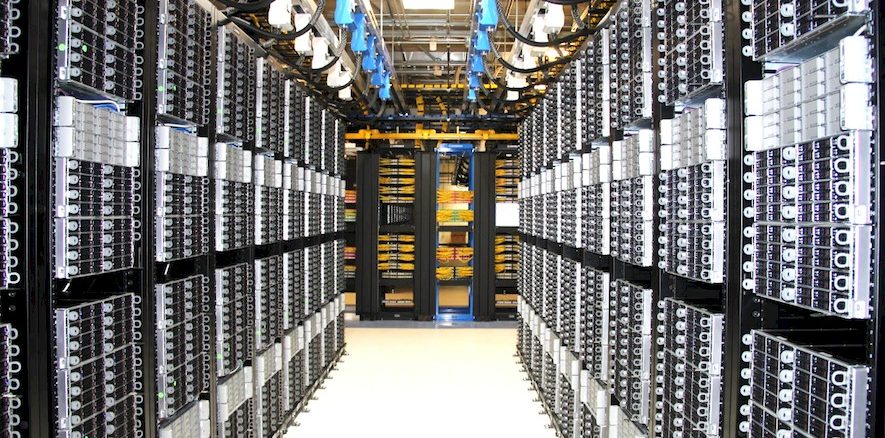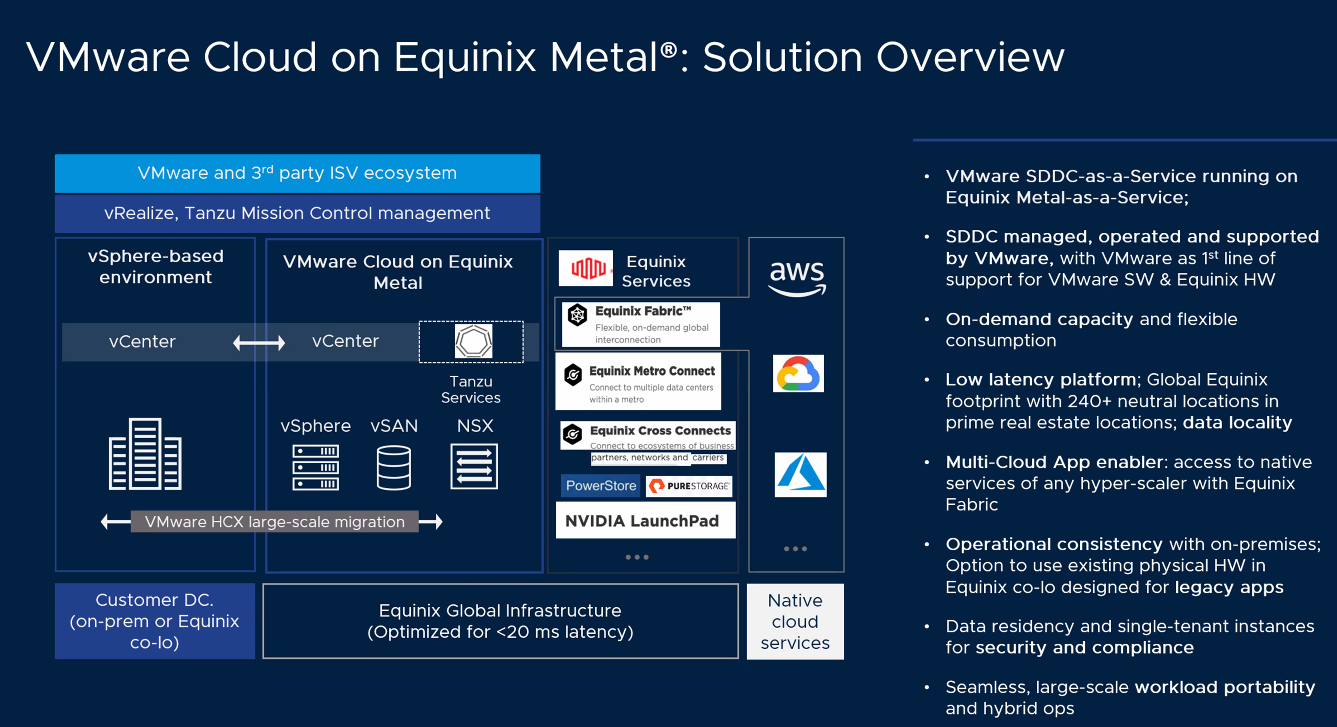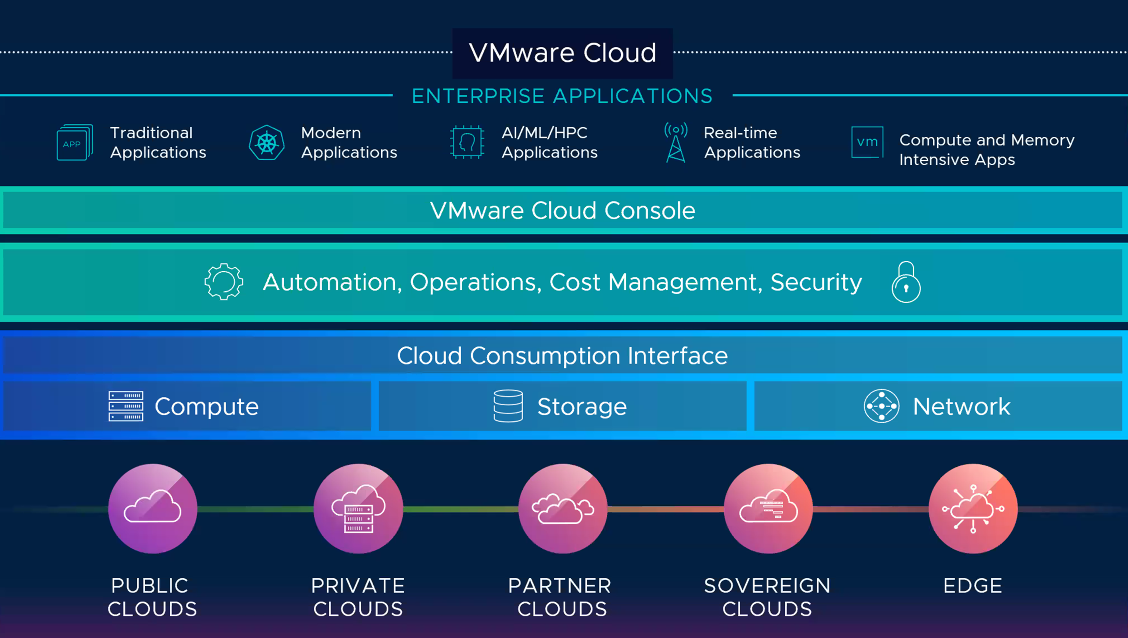
In the ongoing discussions about the still-evolving world of hybrid cloud, the focus tends to be on what enterprises are doing within their own on-premises datacenters – and private clouds – and their work with public cloud players like Amazon Web Services, Microsoft Azure, and Google Cloud.
Lost at times among this hybrid cloud talk is the growing complementary role of co-location facilities, those sites that can provide organizations with a cloud-like experience that can be less costly than a public cloud and offer strong security, high performance, and low latency. In addition, their varied locations can address local regulatory needs as well as enterprise demands as they move more of their compute and storage out to the edge to be nearer to where the data is being created.
VMware and co-location giant Equinix see an opportunity to address those needs. The two companies have been partnering since 2013 making VMware technology available in Equinix datacenters around the world. The companies have more than 3,000 joint customers, with many who are looking for ways to bring the performance and access they have in their distributed multicloud world but in an as-a-service manner, according to Zachary Smith, global head of edge infrastructure services at Equinix.
To this end, the two companies at the VMware Explore 2022 Europe show in Barcelona on Tuesday unveiled VMware Cloud on Equinix Metal, combining VMware’s expansive cloud offerings and Equinix bare metal-as-a-service, one of several cloud-related announcements VMware is making at the event.
“The goal here is to bring cloud-style experiences to the metro-location reach of Equinix,” Smith said in a briefing with journalists and analysts. “We are hearing from enterprises that they want to have access to those locations across the world with that latency-sensitive, high-performance workload but with the ease and consumptive model of VMware Cloud. We’re helping to move that workload to the edge, where thousands of enterprises and service providers are connecting. This is where people can really access that mission-critical data-heavy workload in our metro locations and interconnected across to their cloud workloads, to their on-prem, and to the rest of their ecosystem partners, and to do so with an operating model that they’re very comfortable with.”
The offering will preserve the single-tenant and location-specific assurance organizations are used to in their own datacenters but in a fully managed environment, he said.
Equinix, with its more than 240 highly interconnected datacenters (via the company’s Platform Equinix) in 71 markets around the world, is a top player along with the likes of Digital Realty and DigitalBridge, in a global co-location market that could grow from more than $46 billion two years ago to almost $203 billion by 2030.
Its growth strategy has been fueled in part by an aggressive acquisition strategy that includes its $3.8 billion acquisition of Telecity and $3.6 billion for 24 Verizon datacenters, both in 2016. Four years later, the company bought bare-metal automation specialist Packet for $335 million, giving Equinix a path to the edge through Packet’s capabilities to automate single-tenant hardware.
The Packet technology and the investment Equinix has put into it over the past two-plus years was key to what Equinix and VMware are offering now, Smith said.
“A DNA that Packet brought was a high amount of automation around physical infrastructure, which really unlocked this ability for us to create experience,” he said. “VMware Cloud has done such a great job at creating a first-class, trusted, works-everywhere experience that requires a significant amount of infrastructure substrate, at least from the way we wanted to craft this experience. That DNA and programmability around a physical datacenter has allowed us to take this step.”
Expanding the partnership with Equinix made sense for VMware, a company with deep roots in the datacenter but which has aggressively been pushing out to the cloud and, more recently, the edge, with the goal of being the essential technology vendor in an increasingly distributed IT world.
“In the on-prem world, customers enjoy a lot more security and data sovereignty,” Narayan Bharadwaj, vice president of cloud solutions at VMware, said during the briefing. “They have a lot of control and they continue to run a lot of data-intensive, latency-sensitive applications in that particular world. They also enjoy the flexibility, agility and some of the innovation that the public cloud offers. The ask from customers and many of our partners is, ‘How do we bring this all together? How do we create that on-demand model that the public cloud really pioneered, but then build that in with the performance, data-latency sensitive and the enterprise assurance that all our customers look for?’”
VMware for several years has been building its cloud capabilities through such foundational offerings as vSphere, vSAN storage, NSX networking, the Aria cloud management portfolio, and its two-year-old Project Monterrey, a suite for managing virtual machines and containers in a hybrid cloud environment. It also has developed relationships with the hyperscale cloud providers, particularly AWS but also Azure and Google. The partnership with AWS has been a cornerstone of VMware’s cloud ambitions and the Equinix bare metal-as-a-service deal expands what VMware can do, Bharadwaj said.
“There are many use cases that customers think through for different types of applications that demands different locations and different providers and hardware types,” he said. “From a solution standpoint, VMware is presenting a very consistent solution that customers do enjoy today on VMware Cloud on AWS. It has its own differentiators in that model, in its choice of hardware, different locations, etc. With the Equinix relationship, it has other types of differentiation that are very, very unique. We have seen customers – because it’s the VMware technology that allows for that – going to the public cloud, coming back on-prem for some workloads [and to] co-location as well. As long as it’s on the VMware stack with the hardware compatibility, all of the hard engineering that we have done under the covers, we see customers adopting all kinds of distributed strategies. It’s really application-driven.”
The companies said the use cases for the joint VMware-Equinix service range from smart cities and video analytics to financial market trading, point-of-sale in retail, and workloads using artificial intelligence in the datacenter and at the edge. It also will help enterprises trying to find an as-a-service home for mission-critical workloads, Smith said.
“They need really high-performing infrastructure connected to private networks as well as public clouds so that they can move these mission-critical data-heavy workloads into a cloud-first operating model,” he said. “They have network requirements. Almost everything that we see is around, ‘How do we make better performance? How do we not backhaul as much traffic? How do we get the right data for our machine learning algorithms or for our high-intensity data apps?’ Bringing that compute capability and control plane of VMware Cloud to the edge allows customers to benefit from a much greater TCO and higher performance throughout their application stack.”
The offering will see the VMware Cloud stack delivered as a service throughout Equinix’s Business Exchange (IBX) datacenter platform and providing low-latency access to public and private clouds and IT and network providers through the private Equinix Fabric interconnection.
Enterprises will pay VMware for its cloud software-as-a-service and Equinix for the bare metal-as-a-service capacity.
All this comes amid the ongoing bid by Broadcom to buy VMware for about $61 billion, a move that VMware shareholders late last week approved, pushing the deal forward.







Be the first to comment